Mad Detective: Doubling Down
November 2010
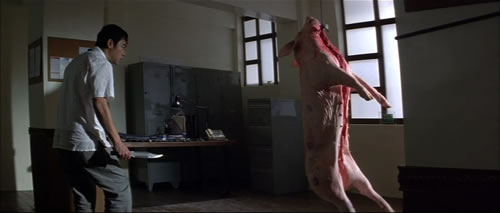
The camera tracks along a fearsome array of knives and cleavers. Cut to a
young man, seen from behind, entering an office at Kowloon West police headquarters.
Cut to a slow tracking shot that reveals a bulky, swaying shadow. A man backs
into the frame holding a knife. The camera continues to glide until it provides
a full view: a gigantic pig is hanging from the ceiling, and detective Bun lunges
forward to stab it. Cut to show the young man, the novice cop Ho, staring at
the spectacle along with other officers. The Mad Detective is tackling another
case.
What will ensue is an urban thriller, showcasing chases, gunfights, and familiar
types—the crooked cop, the overstrung old pro, the newcomer who needs mentoring.
But this policier comes from Johnnie To Kei-fung and Wai Ka-fai, the
moving spirits of Milkyway Image. Their off-center, curiously poignant approach
to the genre makes Mad Detective one of the strangest, strongest Hong
Kong films of recent years.
Johnnie To began as a television director, working in
many genres before committing his energies to cinema in the mid-1980s. 1 He
established himself as a versatile creator with such films as All About Ah-Long (1989)
and The Heroic Trio (1993). He found his voice, he now says, with the
remarkably masochistic cop film Loving You (1995), starring Lau Ching-wan,
who would become central to the To repertory company. While To was reentering
cinema, Wai Ka-fai was writing and producing television series and making his
own 1995 directorial breakthrough, Peace Hotel. The two joined
forces in 1996 and shortly afterward established the Milkyway Image company. 1 He
established himself as a versatile creator with such films as All About Ah-Long (1989)
and The Heroic Trio (1993). He found his voice, he now says, with the
remarkably masochistic cop film Loving You (1995), starring Lau Ching-wan,
who would become central to the To repertory company. While To was reentering
cinema, Wai Ka-fai was writing and producing television series and making his
own 1995 directorial breakthrough, Peace Hotel. The two joined
forces in 1996 and shortly afterward established the Milkyway Image company.
Wai has occasionally directed films for Milkyway, notably
the experimental Too Many
Ways to Be Number One (1997), and he has made films outside the
Milkyway orbit. Johnnie To has often flown solo as well, enhancing the brand
with such acclaimed films as The Mission (1999) and Exiled (2006). On
their joint projects, Wai is usually considered the primary screenwriter, while
To directs. But the collaboration has often taken unusual forms. Some films
credit Wai as screenwriter and a third party as director; but in some of those
cases, To took over the production and saw it to completion. Still other films
credit Wai and To as co-directors. For these projects Wai is involved at every
stage, although To invariably plans and executes the shots.
The Milkyway brand signifies
more than unorthodox teamwork. Its motto might be taken from one of its most
remarkable movies: Expect the Unexpected.
The company aims to be sharply, even peculiarly different from the routine Hong
Kong product. For example, Milkyway gained its commercial footing with star-laden
romantic comedies, but many of those indulge in grotesque exaggeration, such
as a love affair between two gluttons (Love on a Diet, 2001) and a mock-heroic
paean to mahjongg (Fat Choi Spirit, 2002).
The main contribution of Milkyway has been its revitalization of the urban crime
movie. Coming to prominence just when the great age of local film was fading,
Wai and To look self-consciously back to the prototypes crystallized by John
Woo, Ringo Lam, and other masters. The Milkyway Image sensibility recognizes
what made the genre so appealing: blazing set pieces, delirious romanticism,
a delight in pounding visceral energy, and larger-than-life heroes whose ethos
derived from the chivalric swordplay tradition. Wai and To have drawn on these
qualities, but by pushing them in fresh directions, they have conjured up the
most demanding genre films ever to come out of Hong Kong. Their characters are
not die-cast, the plots are labyrinthine, the images are at once lustrous, ominous,
and deceptive. Milkyway has rewritten the rules of the crime film.
Take that opening sequence of Mad Detective. We know the formula: Establishing
shot of Kowloon Police HQ; track with rookie cop as he enters the building and
walks into the office; follow him in as he greets his new colleagues and notices
one is an oddball. Instead, To’s direction splits our attention between
the agitated Bun (the knives, the ballet with the hanging pig) and the timorous
Ho. Already we’re caught off-balance: The shots don’t offer orthodox
exposition or a firmly identified protagonist. The splitting of point-of-view
will be carried on through the movie. The bulk of the film will crosscut between
the two men’s approach to the investigation. Bun is the central character,
but we will need Ho not only as a participant in the action but also as another
mind that will help us grasp Bun’s dementia.
Milkyway characters are often opaque and contradictory, and Bun is a perfect
example. The original Chinese title of the film, “Godly Detective,” might
suggest an all-knowing intelligence. But the character for godly is
also used in the phrase “godly nerves,” which is applied to someone
who has become deranged. Bun is partly the master detective, specifically the
modern figure of the profiler who risks his own sanity by plunging into the mind
of the murderer. Mad Detective boosts the profiler’s empathic
powers to the point of telepathy. Along one dimension, Bun can, by reenacting
the crime, intuit the culprit. That’s the tactic we see in the pig-stabbing
scene and the suitcase episode that follows.
But your standard profiler doesn’t have another
of Bun’s talents:
He can see the “inner personalities” of people whom he encounters.
To him these alter egos become as tangible as the person in front of him. To
complicate matters further, Bun hallucinates, thinking his wife is present when
she is not. This strange mix of mental gift and mental disturbance is dangerous,
as we see just before the opening title credit, when Bun offers his hacked-off
ear as a gift to a retiring superior.
Characteristically, Wai and To do not explain Bun’s
mental powers and defects. No neurosurgeon steps in to give a clinical diagnosis,
as might happen in an American film. The multidimensional madness of the detective
is instead largely a pretext for the sort of playful plot stratagems that have
become a Milkyway hallmark.
Throughout the film we will shift constantly between
watching what Bun perceives and watching things objectively or through Ho’s
eyes. The device is spelled out twice, first at police headquarters when Bun
divines a cop’s objections
to him by visualizing a petty woman complaining. Next, more elaborately, Bun’s
tailing of the suspect cop Ko is presented through a vision of Ko’s many
personalities, embodied as a group of people striding along. The editing here
has to be quite precise, severing our viewpoint from Bun’s in order to
establish what is objectively there. 2 So
we have Ho, following Bun as Bun tails Ko, to confirm that Bun is seeing Ko as
a troop of subpersons. 2 So
we have Ho, following Bun as Bun tails Ko, to confirm that Bun is seeing Ko as
a troop of subpersons.
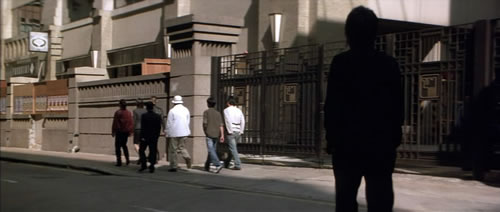
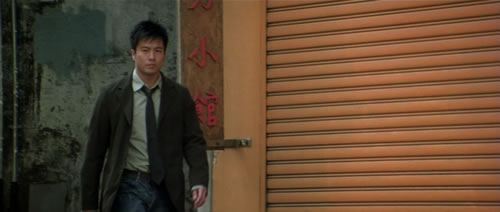
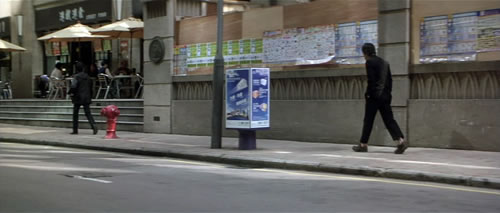
Once established, this shuttling between subjective and objective presentation
is varied as the plot develops. Right to the end, even during the mirror-image
gun battle, we get unexpected glimpses of the shooters’ divided selves,
signaling that we’ve suddenly been transplanted into Bun’s mind.
Wai and To can even afford a quick shot of the Indian crook Shirma’s cowering
inner self, leaving us to infer that we’re seeing him as Bun does.
But the cunning of Milkyway narration emerges much earlier. At the point when
we’re told that Bun senses people’s multiple personalities, we probably
don’t realize that we have already witnessed him doing just that.
The scene occurs only a few minutes into the film and is staged as a perfectly
mundane moment in a quickstop market: He watches one teenage girl urging another
to shoplift.
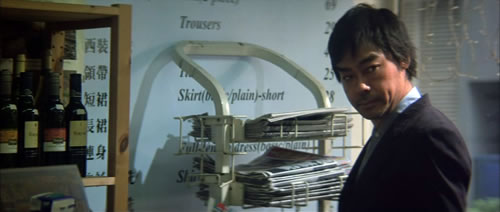
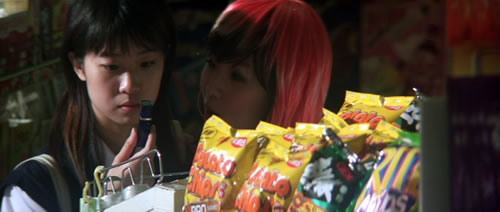
Only later, or perhaps on a second viewing, do we realize that the pink-haired
temptress is actually Bun’s vision of the first girl’s impulse to
steal. What his scolding chases out of the shop is the vision, not a real teeny-bopper.
The quickstop scene initiates a second level of deception as well. In the market
and on the way home Bun is accompanied by his wife May, yet we learn later that
May has left him long ago. The whole quarrel between him and her turns out to
be imaginary. If we can speak of retrospective pathos, our recalling this
scene later in the film may trigger it.
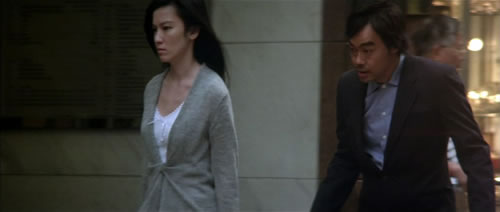
The sadness of Bun’s plight comes out more directly
in a sequence at a café. Here what he thinks is a double date actually
consists of him alone with Ho and his girlfriend Gigi. Bun imagines that May
is at the table with them, sparkling and affectionate at his side. Yet when he
finally meets May face to face, he immediately assigns her another personality,
that of a severe harridan. When May isn’t there, Bun sees her; when she
is there, he sees through her. A great deal of the film’s poignancy comes
from the fact that Bun can never reconnect with his wife in reality.
So we shuttle
between subjective and objective points of view, as Bun both sees into other
people and imagines his wife to be at his side. These mechanisms give To and
Wai a vehicle for their endless fascination with repetition and elision, the
twin hallmarks of the Milkyway movie. Two pairs of cops, two points of view,
two couples, two pistols: these dualities are just the start. Bun’s power
to solve crimes depends on reenactments—at the food mart, at a mahjongg
parlor—and some of those get replayed further. Bun tries to penetrate Ko’s
mind by revisiting the restaurant and endlessly ordering the dishes Ko had ordered.
Bun assumes that the dead cop Wong has been buried in the forest, so to reconstruct
the crime he has himself buried. This triggers a replay of the early scene of
Ko and Wong pursuing Shirma, but now fleshed out to reveal Ko’s murder.
Yet Bun’s burial is already a repetition of Ho’s willingness to copy
his master’s methods; when Ho occupies the grave, Bun gets his first clue
about Ko’s villainy.
Yet all this repetition of situations doesn’t
include repetition of key items of information. Redundancy about clues and hidden
identities is central to the Hollywood-style thriller; the audience can be puzzled
but should not be confused. The typical Milkyway film takes a more elliptical
approach to storytelling. Key items of information may pass so quickly that we
don’t notice their
importance, and they may never be repeated more explicitly. The Mission is
famous for this parsimonious approach; at first viewing it seems episodic, but
after more viewings you can see dramatic crosscurrents underneath. Even more
demanding are the reshuffled alliances and vagrant heads of The Longest Nite (1998).
Only Milkyway could make a film (Throw Down, 2004), in which the audience
might well neglect to notice that the protagonist is going blind.
We’ve already seen elliptical narration at work in the covert introduction
of Bun’s shifting visions, but the strategy extends to smaller details.
Consider the ear. We see Bun saw it off in the prologue, but on his next appearance,
his layered haircut mostly hides that area. Was the ear reattached? Is the hair
covering a deformed ear? No answer is forthcoming for many minutes. Eventually,
during the fight that follows a literal pissing contest, we discover that Bun
is using a fake ear that can become detached.
All of these forces—the reworking
of genre conventions, the play with point of view, the doublings and repetitions,
and a reluctance to repeat or clarify key pieces of data—can be seen in
the round-robin of police revolvers. A policeman loses his gun: How many thrillers
have been based on this premise? Here, the missing gun is Ko’s, snatched
up by Shirma in the forest. Ko kills his partner Wong and takes his pistol. He
then, as our mad detective divines, breaks into the police database and changes
the gun’s registration number
so that Wong’s number is now officially his. But then a string of killings
takes place using bullets traced back to the pistol of the long-missing Wong.
A new investigation starts. So the pistols continue to circulate: Bun takes Ho’s
and Ho must borrow Gigi’s. The convention of the stray gun (already toyed
with in To’s PTU, 2003) has been multiplied by four.
The climactic
confrontation, as pure a piece of cinematic virtuosity as any to come from Hong
Kong in recent years, carries this multiplication further by setting a shootout
in a warehouse full of windowpanes and mirrors. Shirma has been tracked to it,
and Ko, Ho, and Bun converge there. The men stalk one another. The split and
layered reflections evoke not only the climax of Welles’ Lady from
Shanghai but also the confrontation of two doppelgangers at the finale of The
Longest Nite. Four killers now instead of two: the Mad Detective scene
doubles the earlier one numerically as well as dramatically. A barrage of fire
leads to the four men facing off. A brilliant overhead shot shows Ko’s
various personalities, who have also stalked Bun through the mirror maze, caught
in splinters shining on the floor.
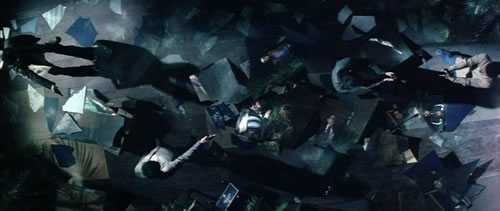
After the last shot has been fired and three men lie dead,
Ho realizes that Bun was right about Ko’s perfidy. But now an official story must be told, and
every bullet accounted for. Ho retrieves his own pistol from Bun’s grasp.
After phoning Gigi to come and be ready to swear that she was there wielding
her gun, Ho sets about swapping pistols. Yet what pistol should go where? Ho
must match the guns to the bullets in the bodies, but more profoundly shouldn’t
he assign guilt where it belongs? When Ho starts redesigning the death arena,
To reiterates the bird’s-eye view, pulling the camera back and spinning
slightly. By shuffling the pistols Ho is starting to stage different versions
of what happened—first making Bun the innocent victim, then making him
Ko’s executioner.
Wai Ka-fai’s plotting makes it hard for us recall which gun is which. As
in other Milkyway films, we get a shell-game of identical objects. But here the
implications aren’t as comic as the byplay with crinkly plastic bags in
To’s sequence of Triangle (2007), and the switches don’t
have the élan of the ploy with the proxy automatics in The Mission.
In the last permutation that we see, Ho wraps Bun’s fingers around the
pistol used in the robberies, making him guilty of Ko’s crimes—as
cruel an outcome as could be imagined. The shot ends before Ho’s new scenario
is completed; for all we know, he might shuffle the guns once more.
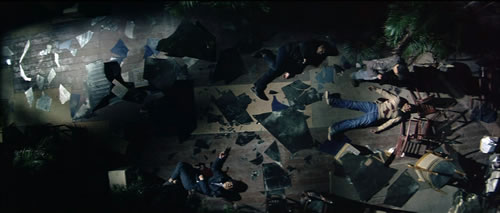
As the camera cranes back and back, Ho’s grave, hesitant
revisions of the fight diagramatically play out the mystifying circulation of
pistols in the story. His maneuver suggests as well the dynamics of a film whose
pleasure resides partly in gaps and repetitions that keep certainty just out
of reach. Mad Detective engages
us in a formal game that, thanks to its teasing opacities, becomes as eccentric,
single-minded, and oddly touching as its protagonist.
Thanks to Shan Ding of Milkyway Image for background information.
Thanks as well to Nick Wrigley for permission to republish this essay, which
appeared in slightly different form in Eureka’s Masters of Cinema DVD release
of The
Mad Detective. That release is still available on UK DVD and Blu-ray here [also
Amazon.co.uk DVD and
Blu-ray].
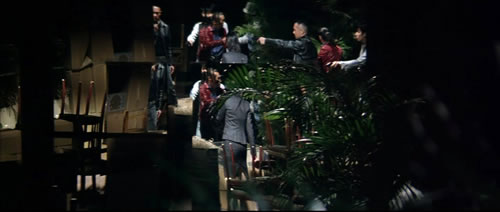
1 : To made
a swordplay feature, The Enigmatic Case (1980), in 1979 before returning
to television. He has said on many occasions that he felt he needed to learn
more about directing. His return to theatrical features began with Happy
Ghost 3 (1986), although
he continued to make some hour-long TV films afterward. To’s fullest account
of his career can be found in Stephen Teo’s interview with him in Director
in Action: Johnnie To and the Hong Kong Action Film (Hong Kong: Hong Kong
University Press, 2007), pp. 215–244.
2 : For
more on the editing of Mad Detective, including an interview with editor
Tina Baz, see my blog entry “Truly
madly cinematically.” Several other
blog entries discuss Milkyway Image; to browse them, see the category entry Johnnie
To Kei-fung. |
|



